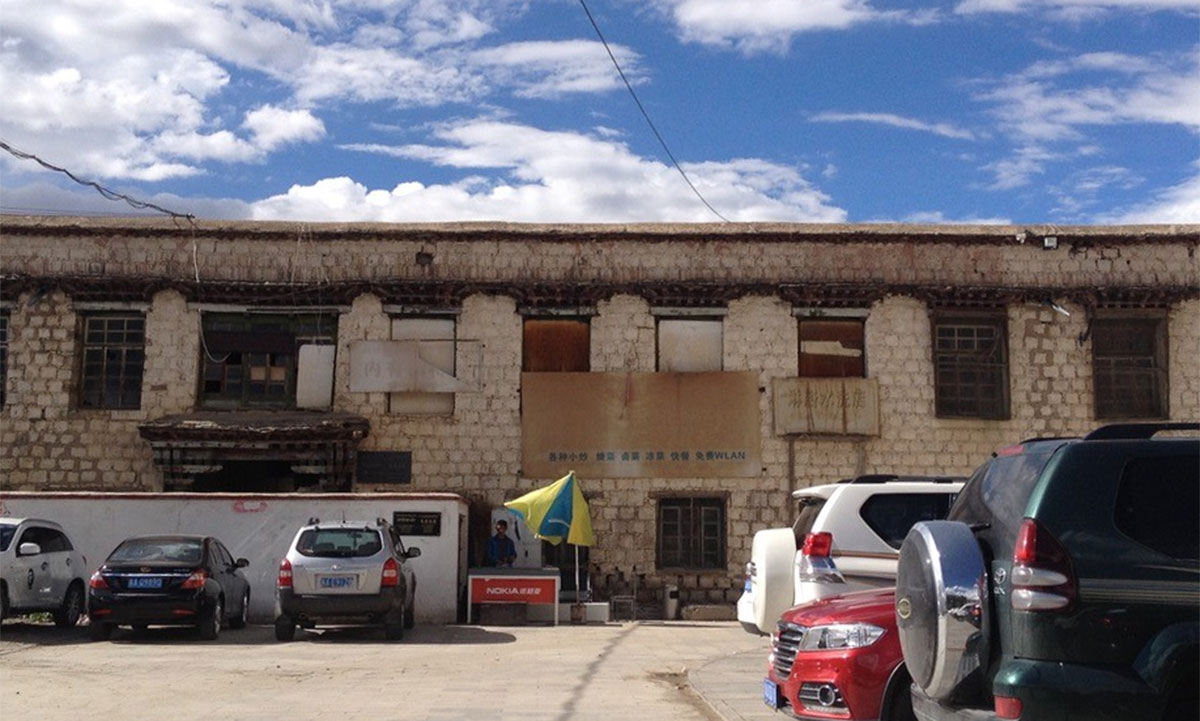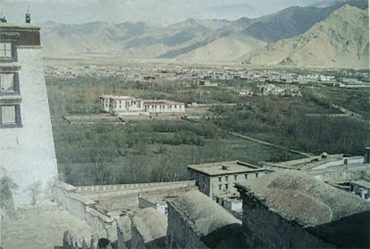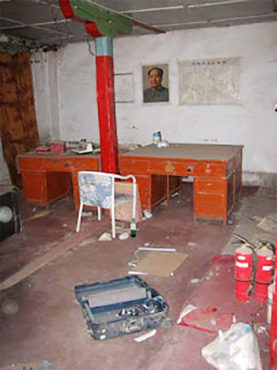
The walls of the Yabshi Takster building, former home of the Dalai Lama’s parents. The building, now demolished, had fallen into disrepair and because of its associations with the Dalai Lama, vilified by the Chinese government, Tibetans were reluctant to raise concern or propose appropriate renovation.
- The former home of the parents of the Dalai Lama, one of the largest and most important of the few remaining historic buildings in Lhasa, has been demolished and a new concrete structure is being built in its place.
- The Yabshi Taktser residence appears to have been razed two months before Lhasa’s protection was discussed at an annual meeting of the world’s leading heritage body, UNESCO from June 24.
The Yabshi Taktser residence was close to the Potala Palace, where the Dalai Lama lived until his escape from Tibet in 1959. It had a particular significance as the home of the late parents of the Dalai Lama. Over many years, the building was neglected and had fallen into a state of disrepair. Tibetans were afraid to recommend maintenance or renovation work because of the building’s association with the Dalai Lama, according to expert sources.
The Yabshi Taktser residence appears to have been razed two months before Lhasa’s protection was discussed at an annual meeting of the world’s leading heritage body, UNESCO, beginning June 24.
Since the iconic Potala Palace and other significant buildings were recognized as UNESCO World Heritage from 1994 onwards, termed by UNESCO as the ‘Potala Palace Historic Ensemble’, dozens of historic buildings have been demolished in Tibet’s ancient capital and the cityscape transformed by rapid urbanisation and infrastructure construction in accordance with China’s strategic and economic objectives. Andre Alexander, the late expert on Lhasa’s heritage, described the Yabshi Taktser building as “the most imposing and important of [these remaining old Lhasa buildings] in terms of architectural value.”[1] It contained an assembly hall for monks and a protector chapel.
Images posted online by the Tibetan writer Tsering Woeser depicted the site after the building was torn down, with diggers and heavy vehicles leveling the ground, and then showed concrete foundations being laid and new construction. The purpose of the new building is not known.
Lhasa, which means ‘Place of the Gods’, was the center of Tibetan Buddhism, a city of pilgrimage, a cosmopolitan locus of Tibetan civilization, language and culture. In a travesty of conservation, and since its ancient core received UNESCO World Heritage status, ancient buildings have been demolished and ‘reconstructed’ as fakes – characterized by China as ‘authentic replicas’ – and emblematic of the commercialization of Tibetan culture.

The area next to the Yabshi Taktser building, former home of the Dalai Lama’s parents, was used as a car park and surrounded by malls. The building, now demolished, had fallen into disrepair and because of its associations with the Dalai Lama, vilified by the Chinese government, Tibetans were reluctant to raise concern or propose appropriate renovation.
The threats to Lhasa’s cultural heritage were raised at the meeting of the UNESCO World Heritage Committee meeting in Bahrain, beginning June 24. Despite the urgency of the threat, the proceedings of the meeting show that the World Heritage Committee adopted a draft decision that had been tabled May 2018 without substantial debate or discussion. The decision requests to send a mission to Lhasa to explore damage to the Jokhang temple after a major fire on February 17, and requested China to submit an updated report on the “state of conservation” of the Lhasa protected area “for examination by the World Heritage Committee at its 44th session in 2020”. In light of the alarming developments in Lhasa, further evidenced by the destruction of Yabshi Taktser, the Committee’s decision is not an adequate response to the threats to the remaining historical buildings in Lhasa.
An International Campaign for Tibet report published to coincide with the meeting warned that Lhasa’s unique and precious remaining cultural heritage continues to be imperiled as China fails to uphold its responsibilities provided by the World Heritage Convention and UNESCO guidelines.[2]
In a response to UNESCO late last year on the ‘Potala Palace Historic Ensemble’ in Lhasa, the Chinese authorities did not mention the key issue of preservation of historic buildings. And in its submissions on Lhasa, the World Heritage Committee too does not outline specific recommendations to protect the historic Barkhor and its surroundings. Chinese planning documents obtained by the International Campaign for Tibet confirm that demolitions are set to continue with the remaining historic buildings, which number around 50 as new construction continues at a staggering rate.

This image shows the Yabshi Taktser before 1959. (This photo was taken from the book “Dalai Lama Prequel” published in 2006 in Taiwan, and used on the blog High Peaks Pure Earth to illustrate an essay)
In the Cultural Revolution, the compound was used as a base for the Red Guards, who ransacked and looted temples and monasteries across Lhasa, and years later drawings of the heads of Marx, Engels, Lenin, Stalin and Mao remained on the walls. According to a Tibetan netizen whose blog is no longer online, Yabshi Taktser “was confiscated by the Chinese government in 1964 and served as a guesthouse until 1990, fulfilling a very important function for government officials of all ranks in times when the Chinese economy was not yet as developed as it is now.” In 1990, it became part of a modern hotel, and commercial houses were built around the courtyard.

A Tibetan netizen whose screen name is ‘Snowland Dust’ posted 16 photos showing Yabzhi Taktser exterior and interior on his blog in 2015. It is still possible to see the heads of the Communist figures that had been drawn onto the inner wall during the Cultural Revolution. The blog is no longer online.
Images of the demolition of the Yabshi Taktser have not been widely circulated so far, which is likely to be linked to the politicized environment in Lhasa. An official circular distributed in Lhasa in February described the protection of Tibetan culture as a “reactionary and narrow nationalistic idea”. The document, which urged the public to report on those suspected of being loyal to the “evil forces” of the Dalai Lama, referred to “22 illegal activities” effectively criminalizing those who speak about issues such as environmental protection and “folk culture” by labeling them as “‘spokespersons’ of the Dalai clique and hostile foreign [non-mainland] forces.”[4]
Footnotes:
[1] ‘The Traditional Lhasa House: Typology of an Endangered Species’ by Andre Alexander, the Habitat International Series, Lit Verlag, Berlin, 2011, pp 107-109
[2] International Campaign for Tibet, ‘Destruction, commercialization, fake replicas: UNESCO must protect Tibetan cultural heritage’, June 25, 2018, https://www.https://savetibet.org/destruction-commercialization-fake-replicas/
[3] International Campaign for Tibet, ‘Chinese policy and the Dalai Lama’s birthplaces’, July 10, 2014, https://www.https://savetibet.org/chinese-policy-and-the-dalai-lamas-birthplaces/
[4] International Campaign for Tibet, ‘Chinese police circular urges public to report on loyalty to ‘evil forces’ of Dalai Lama,’ February 13, 2018 https://www.https://savetibet.org/chinese-police-circular-urges-public-to-report-on-loyalty-to-evil-forces-of-dalai-lama/

